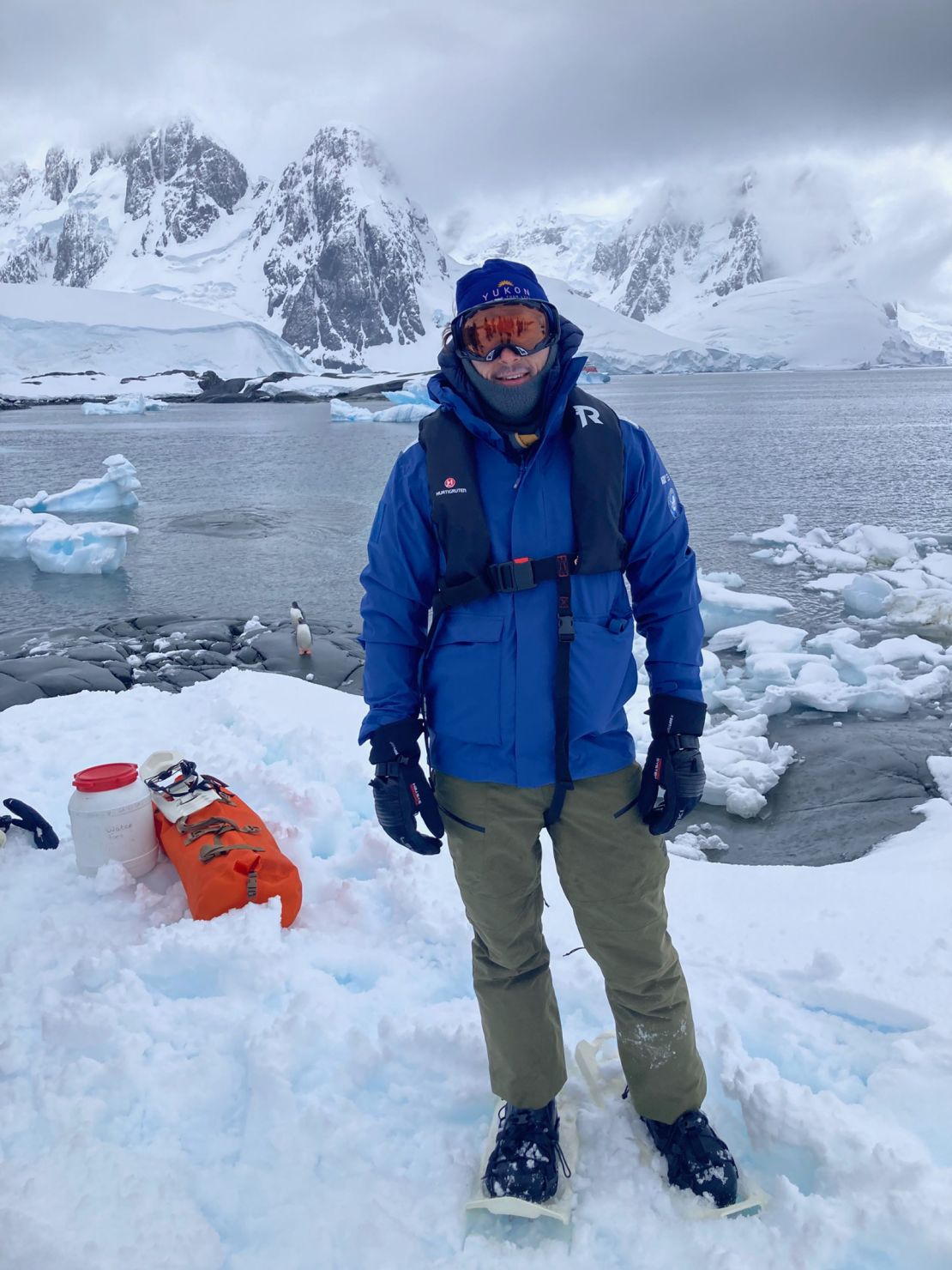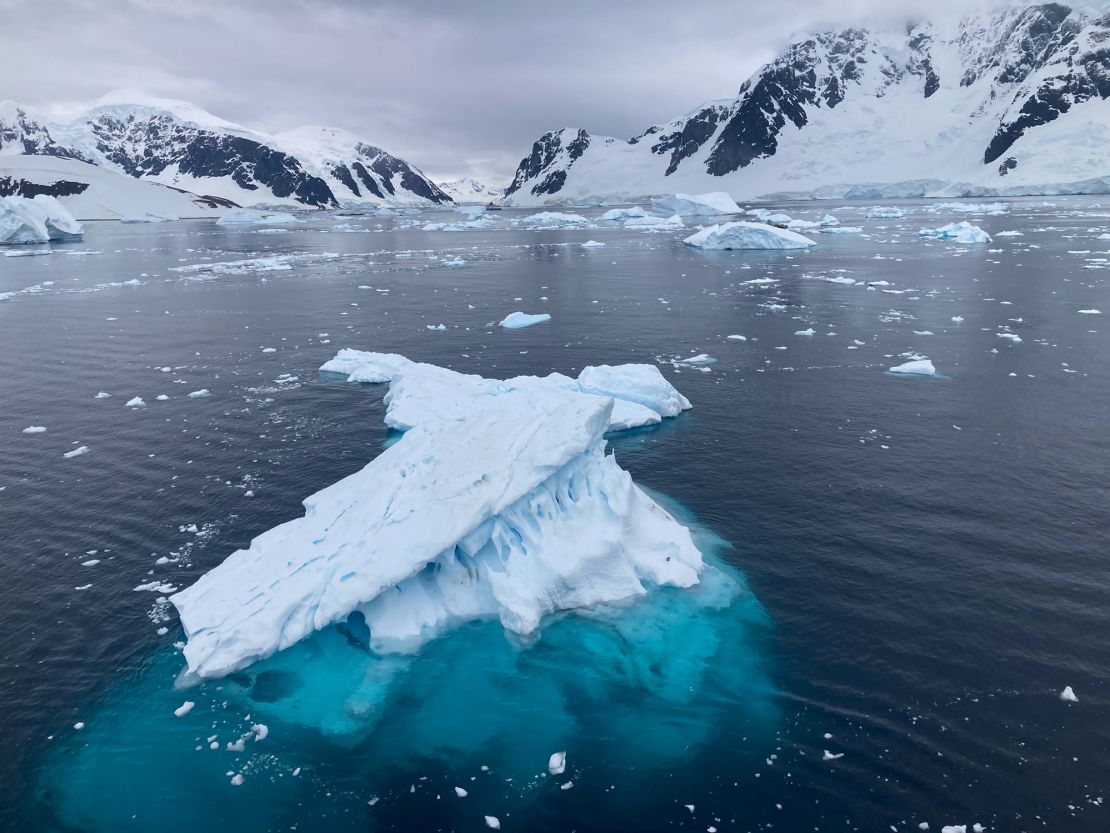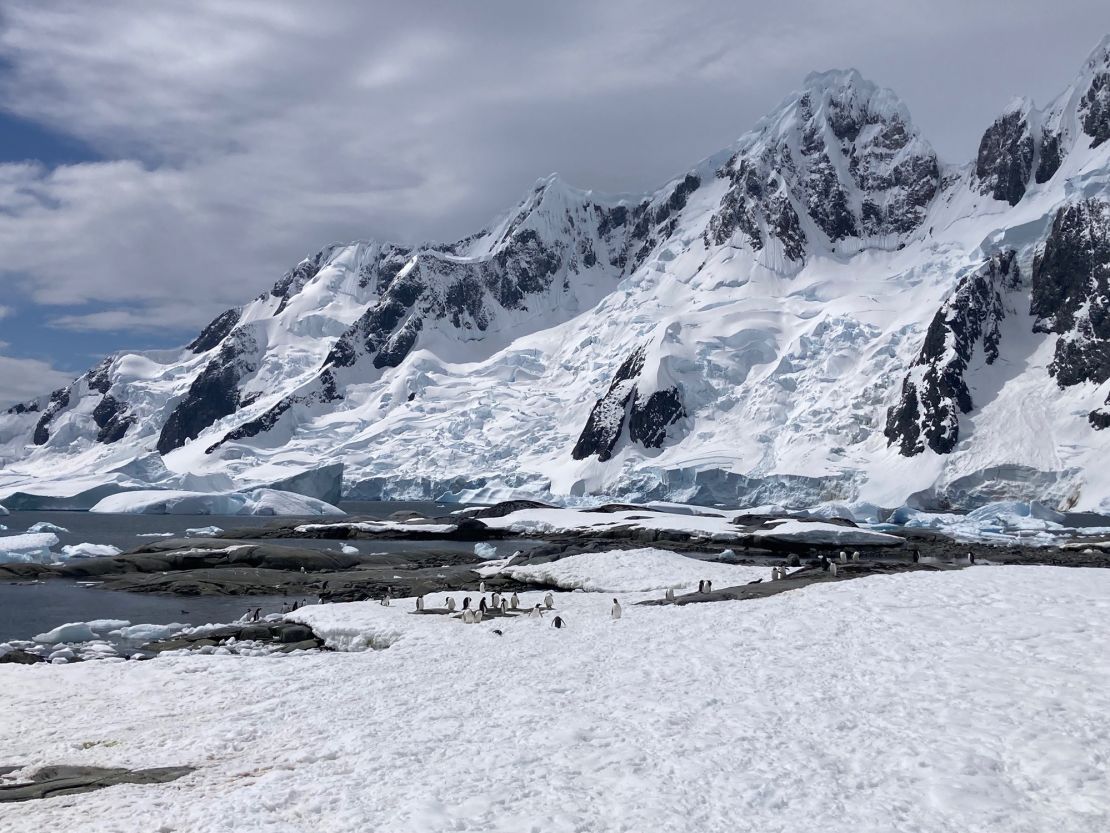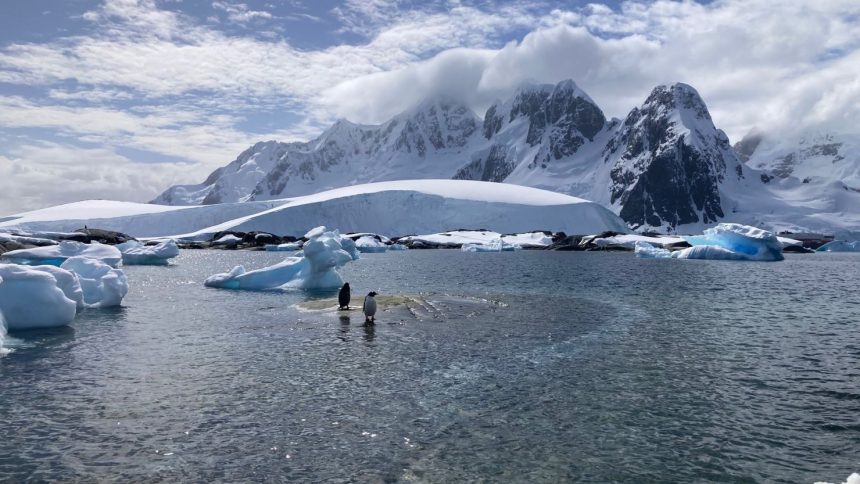CNN
—
Dressed for the coldest conditions, I step out of the zodiac and place my feet on the White Continent for the first time.
I feel a little awkward, because I’m still finding my way in this Antarctic armor. I’m wearing four layers on top, including three jackets, all of their hoods over my head. Thick winter gloves cover my fingers. In my pocket is, of all things, a bag of ashes, which adds to the bulk. I can feel the bump it makes on the right side of my jacket as I bend over and secure my snowshoes.
I brought the bag because, like many travelers, I thought spreading Dad’s ashes somewhere special would be a nice tribute. This June will be 10 years since he died, and it would have been special to share this trip to Antarctica with him. Maybe a ceremonial offering, such as the spreading of his ashes, could suffice.
I’m prepared to spread the ashes on this very walk, amongst the icebergs, mountains, penguins and glacier blue ice. But, before we set off on the snowshoe, the guide gives a safety briefing that cools my jets.
Antarctica has strict regulations — nothing should touch the ground other than our boots. No sitting. No snow angels. No packs on the ground. Do not toss away food or pour out drinks. Under no circumstances should anything be left behind, he says.
When drawing up this dream ceremony, it never occurred to me to think about any rules or regulations surrounding the spreading of ashes. Turns out, not only do ash-scattering restrictions exist, but all around the world, there are specific rules about where and how you can spread them both on land and in the water.

Rules and restrictions in different places
The rules vary a lot from place to place. In the United Kingdom, for example, you don’t need a license or permission to scatter cremated remains at sea, the only guidance being to avoid popular areas such as marinas.
The regulations in the United States differ by state, and the governing bodies vary. For example, the Environmental Protection Agency regulates ocean burials. National Parks oversee their own regulations. State and local governments handle ash policies for non-federal pieces of public land, such as state parks, city parks, inland bodies of water and coastlines.
Generally, it is legal to scatter ashes anywhere on land in the United States so long as you have permission from the private landowner or a permit from the public land-use office. Private land could be your own, your neighbor’s or that of a third-party such as a cemetery or stadium.
For public land, the likelihood of being issued a permit for ash disposal in parks, lakes, streams, and forests will vary by state, with some types of public land — beaches, for one — being off-limits entirely. Yes, scattering ashes along the coast is technically illegal despite it being a common scene we see portrayed in shows and movies.
When holding a ceremony at sea, the general rule is that you must be at least three miles off shore — scattering in the shallows while you stand in the surf is not permitted. You’re also supposed to report the burial to the EPA within 30 days, but there’s no application or paperwork required in advance.
For the most part, the same rules and regulations apply to the transport and dispersal of pet ashes. But there are exceptions. For example, pet remains are not allowed to be buried at sea, according to the EPA (but are they are being used to restore coral reefs in Florida).
Technically, you could be fined for spreading ashes in a restricted area without the proper paperwork or approval.
A violation of the Antarctic Treaty
Antarctica plays by its own set of rules. It is the coldest, highest, driest and windiest continent on planet Earth. It was discovered and reached by man for the first time not much more than 200 years ago. Many of history’s most colorful explorers — James Cook, Ernest Shackleton, Roald Amundsen and Robert Scott, to name a few — were involved in the search for, discovery of and mapping of its icy waters and ice-covered landscape, with many lives lost in pursuit.
According to the guide on my trip, spreading Dad’s remains in Antarctica would run afoul of the Antarctic Treaty that protects the continent’s pristine environment and maintains it as a land of science and peace. Twelve countries, including the United States, originally signed it in 1959 — now, nearly 60 countries participate.
I respect what he’s saying, but I don’t want these ashes burning a hole in my pocket all trip. I decide that “illegal” scattering must happen all the time, and that I’ve come too far to turn back now. I’ll do it in secret, shake the ashes out of my pant leg or something, like Andy Dufresne in “Shawshank Redemption.” I could probably bend over and bury them before anyone knows what happened.
We reach the top of the ridge, eventually stopping on a perch overlooking the lagoon. The view is incredible. The sun peaks out of the clouds, illuminating the ice in the lagoon, and, for the first time, I see the blue of the Antarctic sky beyond the snow-covered peaks. Humpback whales are spouting; penguins waddle on the rocks near the water; icebergs sport a glacial-blue color.
It’s the perfect spot. Turning away from the group, I reach for the bag.

Traveling with ashes is on the rise
My quest is not unique. Consider TIME’s 2013 documentary on cremation’s growing popularity, or CNN’s 2020 article on the topic. Though less than 4% of Americans were cremated back in 1960, more than 50% of people are cremated today, leading to a growth in the number of ceremonial tributes and burials.
The idea of spreading ashes on a trip is popular enough that Carnival Cruise Lines has its own scattering service, where a private event is arranged for families to partake in a burial at sea. Same thing over at Royal Caribbean, and several other cruise companies, whose ships travel far off the coast, beyond the reaches of regulations.
Demand is large enough that smaller, independent boating companies have introduced “ash scattering cruises” in various coastal destinations, with the aim of helping folks get the required three miles offshore. Some offer a surprising variety of services, from the standard “Private Ash Scattering Cruise” to the “Deluxe Unattended Ash Scattering With Video” package.
Transporting ashes through TSA checkpoints and on an airplane is widely accepted, though there are rules about the container that can be used, and they differ slightly by airline, so check with your carrier before flying.
When traveling internationally, it’s a good idea to check a country’s regulations pertaining to cremated remains to avoid a hassle at the border. You may need to present a death certificate and other paperwork at customs upon request.

He is not there
The beauty of the view has me bursting with energy and gratitude. But I notice that every time I look over my shoulder to ensure the guide is still preoccupied, something feels wrong.
What kind of memory am I trying to create here? The one where I can tell everyone that I illegally buried my father? He was a longtime law enforcement official, so I know he wouldn’t approve. And what if the guide sees me and gets upset? Will he think I am disrespecting this pristine environment? How will that memory help me make peace with Dad?
I change my plans and pull out only the prayer card that’s beside the bag. I take a deep breath as I scan the landscape, the snowy hill leading down to the berg-filled lagoon. I see Dad’s smiling face on the front of the card — one of the few good pictures I have of him — then turn it over to see my favorite bereavement poem on the back. I read the words silently to myself:
Do not stand at my grave and weep.
I am not there. I do not sleep.
I am a thousand winds that blow.
I am the diamond glints on snow.
I am the sunlight on ripened grain.
I am the gentle autumn rain.
When you awaken in the morning’s hush
I am the swift uplifting rush
Of quiet birds in circled flight.
I am the soft stars that shine at night.
Do not stand at my grave and cry;
I am not there. I did not die.
Returning down the ridge, I feel open and raw. With the lagoon in full sight, the sound of the shoes on the snow becomes melodic, medicinal. The spirit of the land enters me. I notice the cold air in my lungs. My brain starts buzzing. The thousand winds that blow. The diamond glints on snow. He is not there. He did not die.
Yes, I had wanted to give my dad a proper ash scattering here on my big trip to Antarctica. Like many, I wanted to honor him in that way, with that ceremony. But I think the mission is accomplished regardless. After all, I’m here in this special place, and I’m thinking about him, and there are many days ahead of us.
Maybe it makes sense to spread the ashes closer to home, where he spent his life. Maybe that’s the best idea. I’m not sure. But I know that, either way, it probably doesn’t matter. The most important thing is that I have remembered, once again, that he’s still along for the ride, that he is still with me, today and always.




